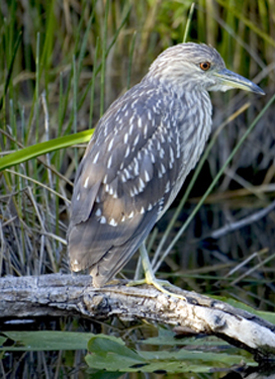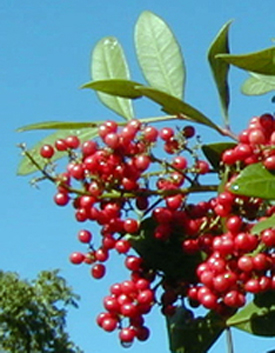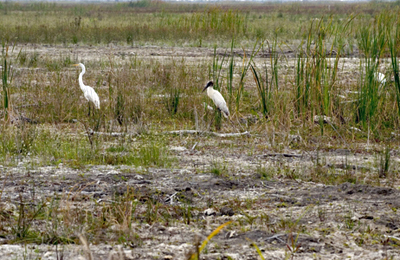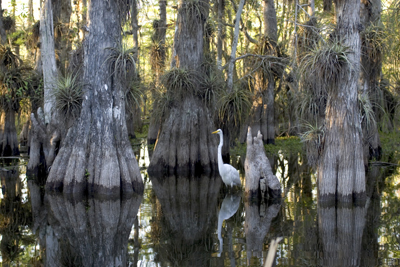
Unwanted plants take root in Everglades
FLORIDA CITY, Fla.— The Everglades National Park was created to preserve the unique ecosystem in Florida. The cypress, mangrove statuary, coastal prairie and Florida Bay have evolved over thousands of years, creating a natural habitat like no other in the world.
Urban development in South Florida has destroyed most of the Everglades. Today, the subtropical wilderness area faces numerous threats to its survival. Among these are the invasive plant species that endanger animals and natural habitat.
 |
An immature black-crowned night heron, one or many native birds in Everglades National Park (Photo courtesy of Rodney Cammauf and the National Park Service). |
The introduction of exotic plants to the Everglades began in the 1800s with the settlement of big populations and has been escalating ever since. Some of the exotic plants that have proven to be a great threat to the Everglades were introduced to the area deliberately in an effort to drain the area.
The Melaleuca, or paperbarks, is an example of such a plant that was introduced to South Florida from Australia for its water consumption.
Biologists estimate that over 60 species of plants have been introduced to the Everglades and up to one-third of the plants in South Florida are non-native. Fortunately most exotics are not considered pests and they do not post a threat to the ecosystem.
The plants that are considered pests are very difficult to eliminate, said park ranger Mason Mcleod. These species thrive beyond their natural range and are highly adaptable and aggressive.
The aggressive plants spread at a very fast pace in part because they did not evolve in the area and have no natural predators in the Everglades. These plants can out-compete the native plants eventually changing the ecosystem and reducing diversity.
This is what happened in the area known to park experts as “The Hole-in-the Donut,” an area of non-native plants surrounded by natural habitat. HID used to be a farm area until 1975. It eventually became dominated by non-native trees like Brazilian pepper and Florida holly.
|
The Brazilian pepper tree and its red berries is an example of an invasive plant that is common in Everglades National Park (Photo courtesy of the National Park Service). |
 |
“Experts are working hard to restore the hole, and they have had a lot of success,” said Mcleod.
The site, which was originally a wetland, was left considerably dry after farming ended. It is now wet for three to six months a year.
Water is one of the main components of the everglades and changes in water flow are among the greatest threats to the park.
“Invasive plants can affect the Everglades water budget by changing the conveyance characteristics for overland flow, by changing evapotranspiration and much more. Speculatively, by changing rainfall,” said John Wang, biologist at the University of Miami.
“The public is not very aware of the invasive plant problem because people tend to think that all plants are good,” said Tony Pernas, exotic plant management specialist from the National Park Service.
Many of the plants that have spread into the wild are brought over for gardening purposes, Pernas explained.
“The public also trust a lot of what the National Park Service does and they don’t think about the tax money that is spent to control invasive plant species,” said Pernas.
 |
Disturbed Everglades National Park land in the “Hole in the Donut” area is being restored (Photo courtesy of the National Park Service). |
Each year, the National Park Service spends more than $12 million controlling exotic plants.
Melaleuca, Australian Pine and Brazilian Pepper are three of the greatest invasive plant threats to the Everglades. But new plants are constantly coming into the area and biologists have little resources to detect the threat until after it becomes a problem.
The fact that is relatively easy to bring a plant from abroad and a lot of people have the ability to travel makes it hard to control what plant species come into the country. The port of Miami aims to check only two percent of the cargo that comes in through their gates, commented Pernas.
“You can even go in the internet and have seeds from plants that we consider noxious delivered to your house from another country,” said Pernas.
Control methods for invasive species may vary depending on the plant from biological to chemical control, but often prevention is the best remedy. “Many people have plants with invasive tendencies planted in their yard and their seeds can be spread by birds or the wind,” said Pernas.
| The great egret in the Everglades National Park (Photo courtesy of Rodney Cammauf and the National Park Service). |
 |
The National Park Service recommends the public not to purchase or use invasive exotic species in landscaping.
Public awareness and education are some of the most important tools for environmentalists when it comes to preventing invasive plants. The Everglades has several programs aiming to educate the public and students about the problem. ‘Don’t Let It Loose’ is one of the programs about invasive species available for teachers and students.
“It was interesting to know that some plants are bad for the Everglades,” said David Velázquez, a fifth grade student that has been learning about the Everglades in his church’s after school program.
“Total eradication of the invasive plant problem is almost impossible,” conceded Pernas. “Our goal is to control the exotic plants and preserve the ecosystem,” he added.

Comments are Closed